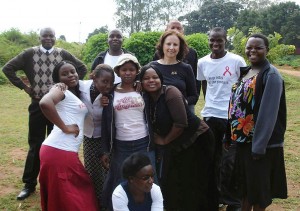Q&A with health and communications expert, Carol Underwood, on reducing the risk of HIV infection among women and girls
Date:

UN Women co-sponsored a side-event on advancing HIV prevention among young people, at this year's Commission on Population and Development in New York on 25 April. Dr. Carol Underwood, a health and communications expert, spoke at the event.
She has examined the gendered nature of HIV risk as the co-author of a new paper: ‘Structural determinants of adolescent girls' vulnerability to HIV: Views from community members in Botswana, Malawi, and Mozambique'.
Here she speaks with UN Women about the concerns and proposals of the communities she consulted - and the links they made between economic empowerment and HIV prevention in young girls. Annah Sango, a young student and activist from Zimbabwe, who presented at the event on behalf of the International Community of Women Living with HIV and AIDS also spoke to UN Women [ watch her interview here ] .
Why are you focusing on HIV risk reduction among women and girls specifically?
Women and girls are more vulnerable than men. This is especially true of girls compared to boys of their same age group: among girls ages 15-24 the level of infection is about three times as great. And this is for both physiological reasons and because of social norms. For example, as adolescents form their identity they want to be part of something bigger than themselves and fit in, so there is consumerist pressure to have certain “trinkets of modernity, as I call them: cell phones or clothes. Because of the larger structural issues, girls then often see themselves as having few options other than to have relations with (usually older) men, who can provide them with something more, economically.
That doesn't mean that other groups aren't at risk. The way that masculinity is defined for example, can put boys and men at risk. In some settings they are expected to have multiple concurrent relationships.
Did your work with focus groups in Botswana, Malawi, and Mozambique reveal unexpected findings or attitudes?
To my surprise, most of the participants didn't blame girls for having “transactional sex. They highlighted the economic conditions of the community and said: “look, she doesn't have many options. They accepted the notion of survival sex, where girls needed food or fees to go to school, or to keep up with social pressure.
We found a concern with the economic exploitation of girls. We heard from adults and adolescents that sometimes parents simply tell their daughters to ‘bring dinner home' - even pre-adolescent girls in some instances. That's coercing girls into sexual transactions.
What were focus groups particularly concerned about?
There was a lot of discussion about violence, sexual coercion and rape in relation to alcohol consumption, and girls frequenting bars. In all three countries we worked in, for example, under-18s are prohibited from accessing alcohol. Yet because laws were rarely enforced, young girls are often found in or near bars, and communities indicated that this was putting girls at risk.
Community members said that men would become more aggressive when inebriated, and the girls would become less protective of themselves. These are risk factors in HIV transmission. The threat of rape seemed to be quite prevalent in the minds of adolescent girls.
What was most commonly called for?
They called for more economic opportunities for girls, and also for their families. They talked about vocational training - small scale enterprises - and making those available at the community level. Many mentioned that there was a need for monitored recreational opportunities for girls and boys, and also for improved adult -child communication; adults weren't sure how to address some of the issues that are arising due to modernity.
They thought that they would need to be more involved in talking to them about HIV risk, in monitoring where they went, and in being good role models. Because when young people know what their parents think about issues, they do take it into account.
What do you hope to bring to the panel on Advancing HIV Prevention Among Young People, and how else are you taking your research forward?
We all agree that individual behavior is an important factor, but I think we focus so much on this, without taking into account the structures that limit the individual ability to act. We miss opportunities to take protective action.
I think that we need to support structural interventions. These include policies that can protect girls, the enforcement of laws, broader economic opportunities and the elimination of school fees to help keep girls in school.
I hope that as we can demonstrate the associations between structural interventions and reduced risk of HIV transmission, policymakers will change their policies so that they are more supportive and protective of adolescent girls, and their communities in general.